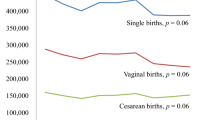Abstract
Background
To identify the current clinical features in diagnosis and treatment for immaturity of ganglia (IG) in Japan, we retrospectively analyzed data for patients with IG from the nationwide surveys in Japan. This survey was performed by Japanese Study Group of allied disorders of Hirschsprung’s disease (ADHD).
Methods
In primary research, data on totally 355 cases of ADHD were collected for 10 years (2001–2010). Fifteen patients were IG. All IG patients were confirmed by pathological examination. In secondary research, detail questionnaires were sent and collected.
Results
Male/female ratio was 9/6 and mean birth weight was 2474 g. All cases (100 %) were onset in neonatal period. Primary symptoms were abdominal distention (86.7 %), vomiting (53.3 %), and late egestion of meconium (26.7 %). An abnormal distention of intestine was recognized in 86.7 % on X-ray, and microcolon was recognized in 58.3 % on contrast enema. Caliber change was recognized in 58.3 % on laparotomy. An enterostomy was made in 13 patients (86.7 %), and an ileostomy was made in 69.2 %. Pathological diagnosis was performed in 100 %. Enterostomy was closed in 100 %.
Conclusions
Totally, 15 definitive cases of IG in 10 years were collected and analyzed. All cases were onset in the neonatal period and almost all underwent enterostomy, but no mortalities occurred.
Similar content being viewed by others
References
Kelleher J, Blake N (2008) Diagnosis of Hirschsprung’s disease and allied disorders. In: Holschneider AM, Puri P (eds) Hirschsprung’s disease and allied disorders, 3rd edn. Springer, Berlin, 145–151
Ravitch MM (1958) Pseudo Hirschsprung’s disease. Ann Surg 147:781–795
Bentley JFR, Nixon HH, Ehrenpreis TH, Spencer B (1966) Seminar on pseudo-Hirschsprung’s disease and related disorders. Arch Dis Child 41:143–154 4
Puri P (1997) Variant Hirschsprung’s disease. J Pediatr Surg 32:149–157
Toyosaka A, Okamoto E, Okasora T, Nose K, Tomimoto Y (l993) Clinical laboratory and prognostic features of congenital large intestinal motor dysfunction (pseudo-Hirschsprung’s disease). Clin Auton Res 3:243–248
Toyosaka A1, Tomimoto Y, Nose K, Seki Y, Okamoto E (1994) Immaturity of myenteric plexus is a etiology of meconium ileus without mucoviscidosis: A histopathologic study 4:175–184
Okamoto E, Toyosaka A. (1996) Pseudo-Hirschsprung’s disease. Research on the pathophysiology, diagnosis and treatment (in Japanese) Nagai-Shoten
Taguchi T, Masumoto K, Ieiri S, Nakatsuji T, Akiyoshi J (2006) New classification of hypoganglionosis: congenital and acquired hypoganglionosis. J Pediatr Surg 41(12):2046–2051
Watanabe Y, Kanamori Y, Uchida K, Taguchi T (2013) Isolated hypoganglionosis: results of a nationwide survey in Japan. Pediatr Surg Int 29(11):1127–1130
Taguchi T, Kobayashi H, Kanamori Y, Segawa O, Yamataka A, Sugiyama M, Iwanaka T, Shimojima N, Kuroda T, Nakazawa A, Oda Y, Miyoshi K, Ieiri S (2014) Isolated intestinal neuronal dysplasia type B (IND-B) in Japan: results from a nationwide survey. Pediatr Surg Int 30(8):815–822
Muto M, Matsufuji H, Tomomasa T, Nakajima A, Kawahara H, Ida S, Ushijima K, Kubota A, Mushiake S, Taguchi T (2014) Pediatric chronic intestinal pseudo-obstruction is a rare, serious, and intractable disease: a report of a nationwide survey in Japan. J Pediatr Surg 12:1799–1803
Watanabe Y, Sumida W, Takasu H, Oshima K, Kanamori Y, Uchida K, Taguchi T (2015) Early jejunostomy creation in cases of isolated hypoganglionosis: verification of our own experience based on a national survey. Surg Today [Epub ahead of print]
Burki T, Kiho L, Scheimberg I, Phelps S, Misra D, Ward H, Colmenero I (2011) Neonatal functional intestinal obstruction and the presence of severely immature ganglion cells on rectal biopsy: 6 year experience. Pediatr Surg Int 27(5):487–490
Park SH, Min H, Chi JG, Park KW, Yang HR, Seo JK (2005) Immunohistochemical studies of pediatric intestinal pseudo-obstruction: bcl2, a valuable biomarker to detect immature enteric ganglion cells. Am J Surg Pathol 29(8):1017–1024
Desmet AS, Cirillo C, Vanden Berghe P (2014) Distinct subcellular localization of the neuronal marker HuC/D reveals hypoxia-induced damage in enteric neurons. Neurogastroenterol Motil 26(8):1131–43
Sumiyama K, Kiesslich R, Ohya TR, Goetz M, Tajiri H (2012) In vivo imaging of enteric neuronal networks in humans using confocal laser endomicroscopy. Gastroenterology 143(5):1152–1153
Ohkubo H, Kessoku T, Fuyuki A, Iida H, Inamori M, Fujii T, Kawamura H, Hata Y, Manabe N, Chiba T, Kwee TC, Haruma K, Matsuhashi N, Nakajima A, Takahara T (2013) Assessment of small bowel motility in patients with chronic intestinal pseudo-obstruction using cine-MRI. Am J Gastroenterol 108(7):1130–1139
Acknowledgments
This study was supported by a grant from The Ministry of Health, Labor Sciences Research Grants for Research on intractable disease. The authors thank The Japanese Society of Pediatric Surgeons, The Japanese Society of Pediatric Nutrition, Gastroenterology and Nutrition, and The Japanese Study Group of Pediatric Constipation. They also thank Dr. Brian Quinn for reading the manuscript, and Ms. Masutomi and Ms. Yamazaki of Department of Pediatric Surgery, Kyushu University, for their help in processing the data.
Author information
Authors and Affiliations
Corresponding author
Ethics declarations
Conflict of interest
No competing financial interests exist.
Rights and permissions
About this article
Cite this article
Ieiri, S., Miyoshi, K., Nagata, K. et al. Current clinical features in diagnosis and treatment for immaturity of ganglia in Japan: analysis from 10-year nationwide survey. Pediatr Surg Int 31, 949–954 (2015). https://doi.org/10.1007/s00383-015-3774-0
Accepted:
Published:
Issue Date:
DOI: https://doi.org/10.1007/s00383-015-3774-0




